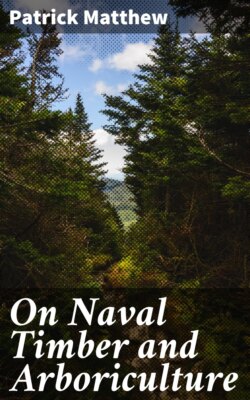Читать книгу On Naval Timber and Arboriculture - Patrick Matthew - Страница 13
На сайте Литреса книга снята с продажи.
NARROW-LEAVED OR ENGLISH ELM—Ulmus campestris.
ОглавлениеTable of Contents
There are few Scotchmen, as they migrate southward, who have failed to remark the tame subdued appearance of the landscape of the middle and south of England, where a number of straggling tufted-headed poles, along with windmill towers, occupy {55} the horizon. These straggling, tall, tufted poles, stuck in, perpendicular to the flat surface, are composed of living narrow-leaved elm-trees, which the perseverance of the peasantry in quest of billets, has reduced to this condition. Some varieties of this elm, however, when uncurtailed in lateral expansion, attain the grandest development, stretching forth a hundred giant arms aloft, supporting masses of foliage, fantastically magnificent.
In the neighbourhood of London, this tree is attacked by an insect, which, running along the outside of the timber, within the bark, in a few seasons deprives the individual of life, the bark peeling off in large girdles, threatening to bereave this capital of the finest ornaments of its parks. We have observed, in different kinds of growing trees, such as the apple and oak, the roads of insects traversing between the rhind and wood, although the individual thus affected appeared to suffer little or no injury; and we consider the agency of the insect in the destruction of the English elm around London to be merely sequent to disease—perhaps a taint of corruption, or slight putrescency of the sap, occasioned by the impurities of the London air, assisted by the hard beaten state of the ground11 above the roots. Should {56} any one examine the inside of the bark of a cut tree, when corruption has just begun with the bark, and see how thoroughly it is undermined by insects, he will, we think, admit the strong probability, that the insect is only subordinate in the destruction of those fine old elms around London. We do not wonder at the condition of the trees—it would not surprise us if the human race in London were swept off by some similar secondary cause.
The small-leaved elm has great disposition to spread by suckers from the roots, and thus extended has become very prevalent throughout most parts of England, in the broad wastes (termed fences), which, from the indolent husbandry, consequent to tithes and the want of leases, generally surround the pasture and corn fields, but which are so necessary to these unvaried plains, as some prominent object, or characteristic land-mark, on which the amor patriæ of the population may perch; the finest remembrances and associations of youth being mixed up with these bushy flower-covered enclosures.
It is with country as with society, strong lasting {57} attachment occurs only where there is individuality of character to give distinctness of image.
“Oh! how should I my true love know,
From many other one?”
There is design and utility in this fascination of peculiarity. If individual distinction be but strongly marked, it signifies little of what character. Love of country often hangs upon features of the harshest and most fearful description, with which the associations and feelings become entwisted, as attachment to individual is often rivetted by fierce, austere, or even morose qualities.
The narrow-leaved elm is valuable for forming the blocks and dead-eyes12, and other wooden furniture of rigging, being particularly suitable for these purposes, from its hard and adhesive nature, and indisposition to crack or split, when exposed to sun and weather.
We have observed many minor distinctions, perhaps individual, in the above kinds of elm, in figure, size and smoothness of leaf, in colour and roughness {58} of bark, &c. Some varieties or individuals of the English elm have the bark of the young twigs and branches covered with corky ridges: others want this excrescence.
